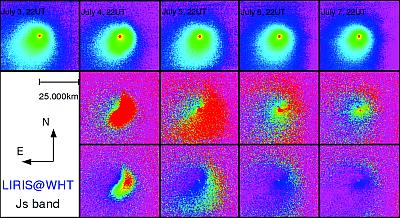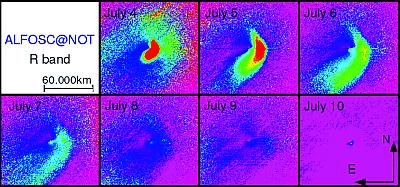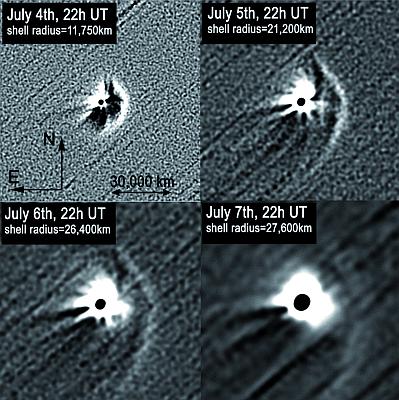 | |||
|
| Home > Public Information > ING Newsletter > No. 10, December 2005 > The Deep Impact Event as Seen from the Roque de Los Muchachos Observatory |
|
|
SCIENCE |
|
|
|
Previous: A Galactic Jet-Blown Nebula Observed with the Isaac Newton Telescope | Up: Table of Contents | Next: Deep Impact Observing at the Isaac Newton Telescope
Article mirrored at: La Palma server | Cambridge server
Other available formats: PDF
The Deep Impact Event as Seen from the Roque de Los Muchachos Observatory
Javier Licandro* (ING and IAC)
At 05:44:36 UT on July 4th, 2005 the Deep Impact (DI) spacecraft collided with comet Tempel1, producing an impact of 19GJ of kinetic energy and excavating a crater shaped by gravity. DI consisted in two spacecrafts: an impactor, weighting 364kg; and a flyby spacecraft for observing the impact and relaying data from the impactor. The main goal of the mission was to study the interior and outer layers of a comet. Until the impact, very little was known of the internal structure and the physical evolution of the outer layers of a comet nucleus. Most of what we know relies primarily on theoretical models. The relationship between the coma’s composition and the nucleus composition is also uncertain. Even if the coma is formed by material from the nucleus, there are several physical and chemical processes that rapidly affect the material ejected from the nucleus.
The DI mission was designed to have much of the mission-critical science done from Earth-based telescopes. An unprecedented worldwide coordinated campaign was organised. Many observatories around the world and in space observed the comet before, during and after the impact, to follow the effects of the event and its evolution.
The Roque de Los Muchachos Observatory (ORM) played a substantial role in this campaign. Starting in 2000, photometric observations performed during several runs by Tozzi and Licandro with the 3.6-m Italian Telescopio Nazionale Galileo (TNG) were used together with others worldwide, to understand the rotational properties of the comet. From March to June 2005 the comet activity was also tracked by our group with the TNG by means of imaging and spectroscopic studies every month. But the interesting part of the game started on July 2nd. From July 2nd to July 10th a campaign involving the three largest telescopes of the ORM, the William Herschel (WHT), the TNG and the Nordic Optical Telescope (NOT) was driven by our group. LIRIS at the WHT was used from July 3rd to 7th to obtain near infrared images in the J and K bands and near infrared spectra. DOLORES at TNG was used from July 2nd to 9th to obtain broad- band images and low-resolution spectra in the visible spectral range. NICS at TNG was used from July 8th to 10th to obtain near infrared images. SARG at TNG was used from July 3rd to 5th to obtain high resolution spectra in the visible range. ALFOSC at the NOT was used from July 3rd to 10th to obtain deep broad-band images and low-resolution spectra in the visible. Also another group lead by Stephen Lowry (QUB) used the INT and the Liverpool Telescope to follow the activity of the comet from July 1st to 7th (see article elsewhere in this issue). The five largest telescopes of the ORM were used simultaneously to track an astronomical experiment in an unprecedented way.
The first aim of the campaign was to study the dust ejected by the impact by using the high S/N images obtained in the visible and near-IR, and the spectra in the near-IR where there are many features due to gas emission. The evolution of the intensity and colour of the dust gives important information on the size of the ejected grains, like their size distribution and ejection velocities. The second aim of the campaign is to measure possible variations of the gas emission by means of visible spectroscopy, to detect any possible new activity in case the impactor penetrated deep enough to meet the fresh ices below the dust mantle. This would evaporate part of them and expose ices to the sun-light generating a new active area.
The impact produced an ejecta cloud of dust easily seen in our images. The wonderful atmospheric conditions (all nights were photometric, and the seeing was as good as 0.4arcsec) allowed us to obtain a set of excellent images in particular in the R and J bands (see Fig. 1 and 2). At these wavelengths the images were sampling the reflected sunlight by the dust in the coma. Our spectra also show that the gas contribution was very low in particular in the near infrared. Some preliminary conclusions about the dust cloud ejecta can be derived from our data:
- The dust ejected by the impact formed a semi-circular expanding cloud that extended from position angles (PA) 145° to 325°.
- Assuming an albedo typical of cometary grain size, the flux of the dust ejecta allowed us to estimate that the total mass of dust ejected was ~106 kg (equivalent to about 10 hours of normal comet activity).
- The orientation of the ejecta proves that the impact happened below the orbital plane of the comet.
- The position of the leading edge of the dust cloud present on the July 4th images show that it expanded outward at a projected speed of about 200±20ms–1 (though varying with azimuth).
- In the following days the shape of the cloud changed because of the effect of solar radiation pressure that moved the dust particles to the tail of the comet (PA=110°). The maximum projected distance in the sunward direction, achieved on July 7th, was 30,000km. By July 9th most of the ejected dust was moved to the coma and the comet looked like as in the pre-impact phase. The ejected dust is diluted in the comet tail.
 |
| Figure 1. First row: Sequence of calibrated near-infrared J-images of the dust coma of comet Tempel1 obtained with LIRIS at WHT. Notice the changes in the images from July 3rd (pre-impact) to July 4th (taken 16 hours after the impact). Second row: Post-impact J-images processed to show only the dust ejected by the impact. Each image has been divided by the pre-impact one obtained on July 3rd. The evolution of the ejecta cloud is clearly seen (see text). Third row: Same as 2nd row shown in a different flux scale. [ JPEG | TIFF ] |

|
| Figure 2. Sequences of processed post-impact R-band images as in 2nd row of Fig. 1. Images were obtained with ALFOSC at NOT. The rainbow scale goes from 1.0 in violet, to 1.5 in red. Notice that on July 9th the image is almost identical to that of July 3rd.[ JPEG | TIFF ] |
The study of the structures of the dust coma in high S/N images (Fig. 3) provided also very interesting results:
- The comet presented some dust structures in the pre-impact phase that indicate that the nucleus had some particularly active regions.
- These structures remained after the impact, thus these active regions were not affected.
- The new structures observed after the impact on July 4th rapidly disappeared and none remained at a high S/N level after a few days.
 |
| Figure 3. Sequences of R-band images obtained with ALFOSC at NOT processed with a Laplacian filtering technique to detect dust structures. Dust jets appear as black straight jets close to the nucleus, dust shells appear as white curved structures. Filtering was optimised to detect the white shell on the right. This shell indicates the day-by-day expansion of the border of the dust cloud ejecta.[ JPEG | TIFF ] |
In conclusion, the ORM campaign showed that the impact was an impulsive event that affected the dust mantle of the comet. A large amount of dust was ejected into the coma in a very short time. In no more than 5 days this dust dissipated. Also, if the impactor reached the fresh-ices below the dust mantle, it did not excavate enough to expose a sufficient amount of ices to create a new region sufficiently active to be easily detected.
Further studies of the dust and gas properties will be done. The images will be analysed with the help of Monte-Carlo modelling techniques to derive the dust grain size distribution and ejected velocities. Visible and infrared spectra will be analysed to determine the gas production rates and the colour of the comet dust.
The scientific team was composed by Javier Licandro (ING and IAC), Miquel
Serra Ricart (IAC), Julia de León Cruz (IAC), Noemí Pinilla Alonso
(TNG and IAC), M. Teresa Capria (INAF), Rafael Barrena (IAC), Mischa Schrimer
(ING), Luisa Lara-López (IAA), and Gian Paolo Tozzi (INAF, Oss. di Arcetri).
¤
*: Email contact: Javier Licandro (
 )
)
| Top | Back |
|

